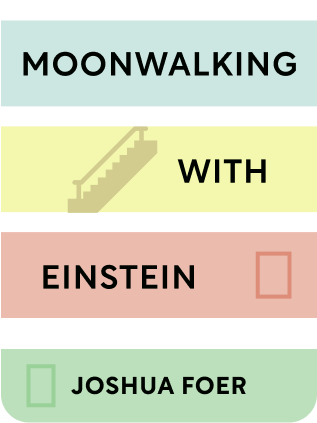

This article is an excerpt from the Shortform summary of "Moonwalking With Einstein" by Joshua Foer. Shortform has the world's best summaries of books you should be reading.
Like this article? Sign up for a free trial here .
What is the history of print, and how does it relate to memory? Did books evolve to help humans with things they couldn’t remember?
The history of print emerged in fairly recent human history. Prior to the written word, humans relied on memory to share stories and ideas. The history of print changed how humans relied on memory.
The history of print and memory are intertwined. Read more about it below.
A History of Print and Memory
It took a long time for humans to learn how our memories work and how to supplement them with external memory aids. How did the history of print change the way we view memory?
In early human history, there was no alphabet, no paper, no writing system—the only way to retain things was memory. Everything was communicated orally, often through poetry or song, because as we learned in Chapter 1, the brain is better at remembering things with structure. When reciting very structured poetry that includes constraints such as imagery, meter, and alliteration, if you forget a word, there are so few options for what it can be that it comes back to you quickly.
Oral communication, by nature, morphs over time. If an easier-to-remember turn of phrase comes up, that’s the version that’s passed on. Unimportant details or tangents fall away. At least until the history of print.
For example, critics think that the Odyssey and Iliad are collections of songs that were shared orally and only written down later. Both works contain mnemonic devices such as repetition, and almost every part of the two poems fits into some sort of pattern. For example, Aphrodite is always referred to as “laughing Aphrodite,” regardless of her emotional state, and the events of both works are predictable and formulaic—rivals, shields, and armies come up again and again.
Poetry didn’t become art until it was replaced as the primary method of transmitting information.
A Timeline of Books
Over time, communication and its requirement for memory changed. Here’s a timeline:
5th Century BC
In the 5th Century BC, the memory arts were widely known and memory was as integral to a classical education as grammar. Before the history of books, having a good memory was a desirable character trait because it meant you had absorbed and understood information, and if you had a good memory, you were seen as a genius. (Allegedly, the memory arts were invented by poet Simonides of Ceos when a banquet hall collapsed in Thessaly. Simonides had visualized the hall and remembered exactly who had been at the dinner and where they’d been sitting. He was able to lead family members to the exact places their loved ones were buried.)
Writing first started to appear in 5th Century BC, but reading and writing still required heavy use of memory. Greek texts were written on scrolls that could be up to sixty feet long. The text was written in scripto continua, which means that there were no spaces, punctuation, or lowercase letters. When text broke across a line, there was no hyphen—it just ran on. It looked something like this: THISISREALLYREALLYHARDTOREADREADINGWASADIFFERENTBEASTINFIFTHCENTURYBC
As a result, the easiest way to parse scripto continua was to read it aloud, and to do that fluently, you had to have some idea in advance of what it said—you had to have previously read it and remembered it. (In fact, Scripto continua is a lot like speech. Speech doesn’t use spaces—when we’re talking, we don’t differentiate between words. This is why it’s hard for computers to recognize speech.)
Additionally, if you didn’t already know a text, you had to read a scroll from beginning to end to learn from it. There were no navigational aids such as chapter divisions or indexes. You couldn’t find a particular piece of information in the middle without reading the whole thing unless you already knew where to look for it.
Throughout the history of books, literacy had its critics. Some people, such as Socrates, thought that all reading could do was remind you of what you already knew. It was nothing more than a cue and it could be dangerous—if you could keep information on a page instead of in your head, people would become ignorant and immoral shells.
400 BC
The parchment codex (similar to a modern book, with bound pages) had almost fully replaced scrolls.
200 BC
In 200 BC, basic punctuation appeared. However, this punctuation was simply dots at the top, middle, or bottom of a line that signified how long a reader should pause.
86-82 BC
Most of the techniques of classical memory training (which are still the basis for memory training today) appear in a book called Rhetorica ad Herennium, or Ad Herennium, which was written sometime between 86 and 82 BC. The author is unknown. For a while, people thought it was written by Cicero, but in Cicero’s writing, he said that the arts of memory were so basic and well known that they didn’t need to be written down.
The Ad Herennium speaks of two elements of memory:
- Natural. Natural memory is your inherent ability to remember things.
- Artificial. Artificial memory is how you train yourself to remember things. It has two components:
- Images. Images are used to hold the meat of what you’re supposed to remember.
- Places. Places are where you keep those images.
(More on training your memory in Part 2.)
The Early Centuries AD
This was an important time in the history of books. Bound books started to appear in the 1st century AD, but they were expensive and labor-intensive to produce. You’d probably never encounter the same book more than once, so you studied and memorized it so you could retain what you’d learned.
Even if you did have consistent access to a book, it was hard to find the particular piece of information you were looking for without scanning the whole thing (indexes hadn’t been invented yet), so it was more practical to just learn the information. When you were learning a book, you weren’t just learning the contents; you were organizing the information in your brain in a way that allowed you to easily access it again.
For a little while, Latin scribes tried including “spaces” (dots) in scripto continuo, but in the second century AD, texts went back to running letters together. Spaces wouldn’t appear again for almost another full century. This tells us that people read to remember a text they already knew, not to learn new information.
9th Century
In the 9th century AD, writing adopted spacing and more sophisticated punctuation, which allowed people to read silently to themselves rather than aloud.
13th Century
The first concordance of the Bible was created in the 13th century AD. A concordance is a list of phrases and words in the Bible with a reference to where they appear. It’s a little bit like an index, in that you don’t have to read a whole book to find a particular piece of information. Around the same time, bookmaking had advanced enough that the text of the Bible could be collected in one volume, but this single volume was still over ten pounds.
Shortly after the biblical concordance, tables of contents, page numbers, and indexes came into use. Indexes were particularly important—you no longer had to read a book from the beginning until you found what you wanted. You could go directly to the part you needed.
After indexes, people didn’t need to remember the contents of books because they could quickly access particular bits of information. Being intelligent became less about what you held in your head and more about if you knew how to access information when you needed it.
An index can’t compete with the brain, however, and the brain is still the best random-access indexing system in existence. An index entry in a book will give you a page number on which the term appears, and then you have to turn to the page to access the information. Your brain doesn’t need a page number—it just supplies you with a memory, regardless of where that memory is stored.
1440
In 1440, Gutenberg invented the printing press. Now, it was much easier to make new books and make copies of existing books. Books became more commonplace and affordable enough that the average person could own a book.
16th Century
Interestingly, memory techniques underwent a resurgence even as the need for an internal memory decreased due to mass-produced books and indexes. In the Renaissance, people became re-interested in Plato’s idea that our world is just a shadowier version of an ideal reality. Guilio Camillo believed that there was a set of magical images that represented everything in the universe. If you could just memorize those images, you would learn the workings of the entire universe.
To this end, Giulio Camillo made plans to build the “Theater of Memory.” The Theater of Memory was architecturally similar to a Roman amphitheater, but where the spectators would have sat, there were paintings and boxes and drawers of cards. Everything that was known about the universe was written on the cards. However, you weren’t supposed to physically visit this building to learn the information; you were supposed to mentally visit it. The idea was that if you visualized the image of a painting, the information stored near that painting would pop into your head.
The Theater of Memory was never finished.
A second notable figure on the timeline of books was Giordano Bruno. Inspired by the mystic and philosopher Llull, Bruno came up with a device that would let him turn any word into an image, thus allowing him to better remember the word. The device was composed of a series of concentric circles, similar to a cipher wheel. Each circle had a letter pair that corresponded to an image, action, adjective, object, and circumstance. If you turned the wheels to spell out the word, you’d end up with a memorable image. For example, the Latin word cr/oc/it/us is Pilumnus (a Roman deity)/riding a donkey/with a bandaged arm/and a parrot sitting on his head.
The church was concerned about the potential occult implications of the device and Bruno was burned at the stake during the Inquisition.
19th Century
In the 19th century, and to some extent today, memory became about learning things quickly. Many people wrote self-help books about memory, notably Professor Alphonse Loisette, who wrote about classical mnemonics but claimed the ideas were all his own.
Another notable figure during this time was Samuel L. Clemens, better known as Mark Twain, who first encountered the memory arts at a memory course Loisette was running. Twain went on to use mnemonic systems such as attaching each topic of a speech to each one of his fingernails. Additionally, he taught his children the order of the reigns of English monarchs by mapping them out with pegs in his backyard (the distance between the pages represented the length of reign). Twain tried to sell the peg game but it didn’t take off.
Today
These days on the timeline of books, the memory arts aren’t associated with intelligence, virtue, or spirituality, and most people don’t learn them. Until 1991, there wasn’t even a contest associated with memory—odd in a world that has competitions in everything from science fairs to hobbyhorsing.
Over the years, our relationship with reading has completely changed—how much we read is more important than what we read or what we retain from it. Our reading has become extensive rather than intensive.
Our relationship with writing has also changed—we trust writing more than our own memories. Writing is less fallible, more accurate, and free of the “editing” unconsciously involved with passing things on orally.
Additionally, the digital age has changed the timeline of books. There are far more ways to externalize our memory than just reading and writing—we have cameras, the internet, and lots of digital storage space.
As a result, most people aren’t good at memorizing. According to a 2007 survey:
- 33% of British people under thirty can’t remember the landline number of their homes.
- 30% of adults can’t remember more than three immediate family members’ birthdays.
The history of print changed how humans remember things. But how much? We may never know, but now humans have many tools to aid with memory.

———End of Preview———
Like what you just read? Read the rest of the world's best summary of Joshua Foer's "Moonwalking With Einstein" at Shortform .
Here's what you'll find in our full Moonwalking With Einstein summary :
- The memory techniques that took the author from novice to US memory champion in one year
- The 6 key types of memory we use everyday
- Why memory isn't just genetic, and how you can improve your memory with the right techniques






